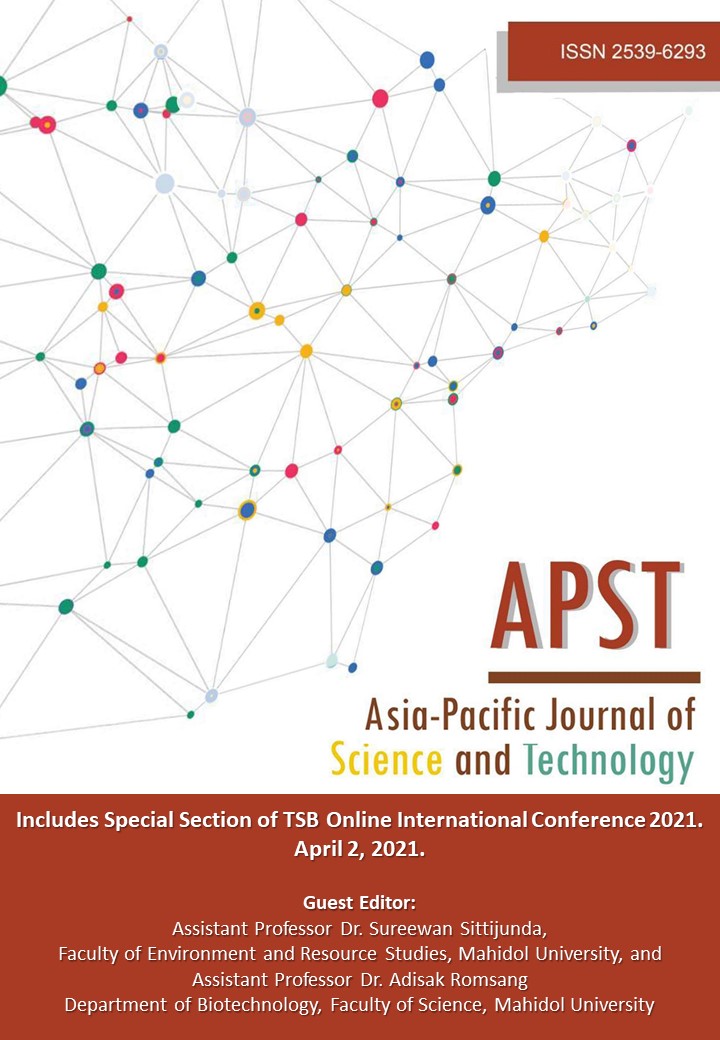Bioethanol scheduling production with a combination of oil palm trunks and empty fruit bunches
Main Article Content
Abstract
Bioethanol production from lignocellulosic biomass is a combination of batch and continuous processes. Such processes mainly consist of pretreatment to recover the highest possible content of cellulose during fermentation using hydrolysis and yeast to convert cellulose into bioethanol with purification to produce the required level of biofuel concentrate. This study aims to develop a simulation model for producing bioethanol from oil palm trunks (OPTs) and empty fruit bunches (EFBs), involving the batch scheduling of pretreatment and fermentation to produce 99.0% wt. bioethanol at 10,000 L/day. Furthermore, OPTs and EFBs offer the flexibility to change feedstocks which also affects the schedule. In this study, Aspen Plus calculates the raw materials and utilities required using the Aspen Batch Process Developer (ABPD) and then schedules the batch operation. To produce bioethanol, the results indicate that OPTs and EFBs with a ratio of 1:1 should be fed 24,000 kg-OPTs/day and 24,000 kg-EFBs/day to produce the required amount of bioethanol. The pretreatment section should be operated in two cycles and fed into a fermenter every 240 min. Moreover, to schedule the fermentation process, ideally, 15 parallel fermenters should be used to ensure a continuous supply for purification. Extractive distillation and pervaporation technologies are proposed in this study, consuming 16.78 and 19.24 MJ/L, respectively, to produce bioethanol in the targeted amount.
Article Details

This work is licensed under a Creative Commons Attribution-NonCommercial-NoDerivatives 4.0 International License.
References
Rajeev KS, Reeta RS, Gincy MM, Ashok P. Cellulase production using biomass feedstock and its application in lignocellulose saccharification for bio-ethanol production. Renew Energy. 2009;34:421-424.
Marina OSD, Marcelo PC, Rubens MF, Antonio B, Charles DFJ, Carlos EVR. Simulation of investigated first and second-generation bioethanol production from sugarcane: comparison between different biomass pretreatment methods. J Ind Microbiol Biotechnol. 2011;38:955-966.
Afrasiab KT, Imrana NS, Kiettipong S, Nikhom L, Sarote S, Wirat V, et al. Two-step pretreatment of oil palm trunk for ethanol production by thermotolerant Saccharomyces cerevisiaesc 90. Bioresour Technol. 2021;32:124298
Natchanok P, Udomsin R, Anusith T, Penjit S, Chen-Guang L, Xin-Qing Z, et al. Chemical-free fractionation of palm empty fruit bunch and palm fiber by hot-compressed water technique for ethanol production. Energy Reports. 2019;5:337-348.
Yanina F, Jorge MM, Gabriela C. Simultaneous design and scheduling of a semicontinuous/batch plant for ethanol and derivatives production. Comput Chem Eng. 2012;36:342-357.
Abdelaziz T, Christian J, Carmen J, Bernd AM, victor P, Demetri PP. Design and optimization of a large-scale biopharmaceutical facility using process simulation and scheduling tools. Pharm Eng. 2010;30:1-9.
Pattarawadee S, Thongchai RS. Heat integration and batch scheduling of optimal bioethanol production. Int J Renew Energy Res. 2020;10:1376-1384.
Darunwan C, Thingchai RS. Plant-wide process simulation of ethanol production from empty fruit bunch. KMUTNB Int J Appl Sci Technol. 2018;11(1):53-61.
Julian AQ, Carlos AC. Process simulation of fuel ethanol production from lignocellulosics using Aspen Plus. Ind Eng Chem Res. 2011;50:6205-6212.
Opor L. Process simulation of ethanol production from palm residues [Dissertation]. Bangkok: Kasetsart University; 2020.
William LL, I-Lang C. Design and control of distillation systems for separating azeotropes. New Jersey:John Wiley & Sons, Inc.; 2010.
Alfani F, Gallifuoco A, Saporosi A, Spera A, Cantarella M. Comparison of SHF and SSF processes forbioconversion of steam-exploded wheat straw. J Ind Microbiol Biotechnol. 2000;25(4):184-192.
Norfadhilah H, Koji T, Kunio Y. Solid fuel from oil palm biomass residues and municipal solid waste by hydrothermal treatment for electric power generation in Malaysia. Sustainability. 2019; 11:1060.
Penjit S, Anusith T, Thongchai RS, Pramuk P, Chularat S, Monsikarn V, et al. Techno-economic analysis for bioethanol plant with multi lignocellulosic feedstocks. IJRED. 2020;9(3):319-328.


